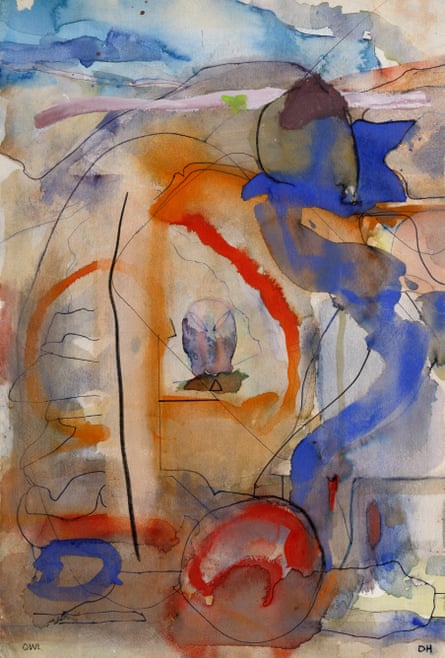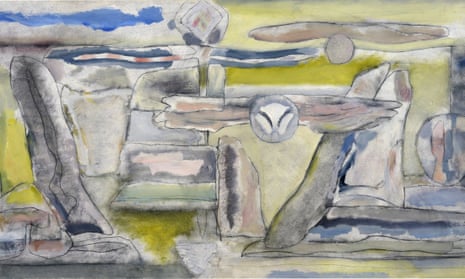The painter Derek Hyatt, who has died aged 84, found in the landscapes of Yorkshire a subject of unending variety. Turning his back on London and on fashion, Hyatt produced distinctive, richly coloured paintings occasioned by events that he called “meetings on the moor” – the movement of a distant figure through a bright field of hay or the sudden appearance of a kestrel against the sunset. His idiom oscillated suggestively between precise picturing of natural details and a mysterious symbolic language. Acutely aware of the historical resonances of his native landscape, Hyatt sketched bronze age stone carvings on Ilkley Moor, finding them a model of direct communication through shape and form.
Although he never courted celebrity, Hyatt remained a presence on the London art scene for more than 50 years. His work emerged at the New Art Centre in Chelsea in 1963, with a well-received exhibition of flamboyant, large-scale gouache landscapes that flirted with abstraction. Later, he was championed by the art dealer Leslie Waddington, who mounted a series of exhibitions in the 1970s focused on Hyatt’s smaller, jewel-like oil paintings. Elements of topography returned, revealing the intricate geometry of the drystone walls and field systems of the Yorkshire Dales.
A key ally in the 80s was the critic Peter Fuller, in whose journal, Modern Painters, Hyatt was acclaimed as one of Britain’s finest painters. The two shared a fascination with John Ruskin, admiring his mystical engagement with nature and myth, and his commitment to drawing. Hyatt assembled works from Ruskin’s collection into a suggestive bricolage at the Ruskin Museum in Sheffield, and in 1990, the year of Fuller’s untimely death, Hyatt was elected a Companion of the Guild of St George, the utopian charity founded by Ruskin. In 2001, a retrospective of four decades of Hyatt’s work, at Cartwright Hall, Bradford, revealed anew its range and originality.

Hyatt was born in the West Yorkshire town of Ilkley. Nothing in his family background suggested an artistic career. His father, Albert, who had served in the Royal Flying Corps in Egypt in the first world war, volunteered for the local air defence unit in the second, and rewarded his son’s accurate drawings of a Spitfire Mk IX with a sixpence. There were quieter times too. On childhood walks with his grandfather on Ilkley Moor, Derek learned to watch with rapt concentration the natural rhythms of life and death and the cycle of the seasons. His mother, Dorothy (nee Sproat), from a local family, took quiet pleasure in Derek’s achievements throughout her long life.
It was at Ilkley grammar school that a singular talent emerged, as Hyatt fell under the spell of a large reproduction of Bruegel’s Hunters in the Snow. As a teenager he developed a passion for tennis, playing on courts at Ilkley that command a fine view of Wharfedale. Ever after, he saw artistry in a fine backhand volley just as he did in an old master drawing. After studying at Leeds College of Art from 1948 to 1952, he completed national service in Norwich, where he took courses part-time at the school of art, while admiring the watercolours of John Sell Cotman at Norwich Castle Museum – and also working on his tennis, playing for the RAF.

In 1954, he won a scholarship to the Royal College of Art, where he initially studied printmaking. Although he soon moved to painting, the precision of line required of an etcher remained central to Hyatt’s practice. A postgraduate fellowship in 1957 employed him as editor of the Royal College’s journal, Ark, whose contribution to postwar British art was pivotal. But already he was veering away from the mainstream. Like Peter Lanyon, whom he admired, he favoured the abstract expressionists over American popular culture. Despite a love of westerns, especially Shane, he found little of interest in the emergence of pop art.
In 1960 he married Rosamond Rockey; their daughter, Sally, was born in 1962. Musical and well read, from a Cornish family, Rosamond had a gift for organisation that was a complement to her husband’s mercurial character. After a decade in the south, Hyatt leapt at the opportunity to move back to Yorkshire in 1964, taking a teaching position at Leeds Polytechnic (now Leeds Beckett University), where he became a senior lecturer in 1966. Generations of students benefited from his generous, quietly spoken advice, and from the connections he wove with other art forms, especially dance. There he collaborated with the mime artist Lindsay Kemp and with the poet Ted Hughes, whose work he greatly admired.
Although the family settled in Collingham, near Wetherby, the moors remained Hyatt’s defining subject. In 1975, he purchased a 17th-century farmhouse in Bishopdale, reached by a precipitous and deeply rutted track. Named Barker, it clings to the moor edge, 1,000ft above sea level. From the window of his makeshift studio there, he could see curlews and swallows passing at eye level. He thrilled, too, to the sudden appearance of RAF jets from a nearby airbase, which reminded him of his wartime planespotting.
Hyatt’s paintings transcend topography but preserve, in layers of vivid colour, the dance of light across that ancient Yorkshire landscape. He continued to paint well into his 80s, and exhibitions in 2012 and 2014 at Art Space Gallery in London included bold new work; another is planned for 2016.
Rosamond died last year. Hyatt is survived by his daughter and two grandchildren.

Comments (…)
Sign in or create your Guardian account to join the discussion